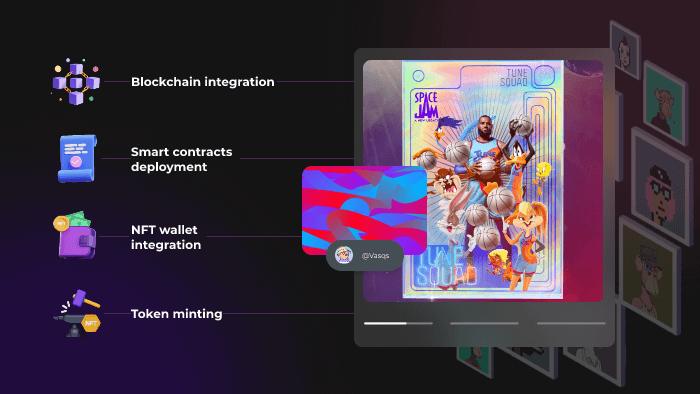Content Attributes
What is a Cross-Chain NFT Marketplace?

Understanding NFTs
Non-Fungible Tokens (NFTs) are digital assets that represent ownership of a unique item or piece of content. These can include art, music, videos, and other digital creations. NFTs are often built on blockchain technology, which provides an immutable and transparent record of ownership and transaction history.
What is a Marketplace?
A marketplace is a platform where buyers and sellers can exchange goods or services. In the case of NFTs, a marketplace is a platform where NFT creators can sell their digital creations, and buyers can purchase and trade them.
Cross-Chain NFT Marketplaces
Cross-chain NFT marketplaces are platforms that allow for the trading of NFTs across multiple blockchain networks. This means that NFTs can be created on one blockchain network, but still, be bought and sold on other blockchain networks. It provides more liquidity and accessibility for NFT creators and collectors.
How Does it Work?
It uses a technology called cross-chain bridges to enable NFT trading across multiple blockchain networks. These bridges allow for the transfer of NFT ownership from one blockchain network to another, without losing the immutable and transparent record of ownership and transaction history.
For example, if an NFT is created on the Ethereum blockchain, it can be listed for sale on a cross-chain NFT marketplace that also supports the Binance Smart Chain. A buyer on the Binance Smart Chain can purchase the NFT, and the ownership is transferred to their wallet on the Binance Smart Chain, without affecting the original ownership record on the Ethereum blockchain.
Benefits of Cross-Chain NFT Marketplaces
It provides several benefits for NFT creators and collectors. Firstly, they create a more liquid market for NFTs, as NFTs can be bought and sold across multiple blockchain networks. This means that NFT creators can reach a larger audience, and collectors have more options to purchase and trade NFTs.
Secondly, This provides more accessibility for NFT creators and collectors. As different blockchain networks have different fees and requirements for NFT creation and trading, cross-chain NFT marketplaces allow for more flexibility and options for NFT creators and collectors.
Examples of NFT Marketplaces
Some examples of cross-chain NFT marketplaces include OpenSea, which supports multiple blockchain networks such as Ethereum, Polygon, and Binance Smart Chain, and Rarible, which also supports Ethereum and Polygon. Other Platforms include Polkamon, which supports the Polkadot blockchain, and Mintable, which supports Ethereum and Binance Smart Chain.
How To Launch A Cross-Chain NFT Marketplace?

As the world of Non-Fungible Tokens (NFTs) continues to grow, It has become increasingly popular. These marketplaces allow for the trading of NFTs across multiple blockchain networks, creating a more accessible and diverse market for NFT collectors and creators. If you are interested in launching your own cross-chain NFT marketplace, here are some steps to consider:
Understand The Basics Of Cross-Chain NFTs
Before launching a marketplace, it is essential to understand the basics of how cross-chain NFTs work. Cross-chain NFTs are NFTs that are created on one blockchain network but can be traded on multiple blockchain networks. This means that users can buy and sell NFTs across different blockchain networks, creating a more liquid and diverse market. To enable cross-chain NFT trading, a marketplace must integrate with multiple blockchain networks.
Choose The Right Blockchain Networks
When launching a marketplace platform, choosing the right blockchain network is critical. There are several blockchain networks to consider, including Ethereum, Binance Smart Chain, Polygon, and others. Each network has its advantages and disadvantages, so it is essential to research and select the networks that best suit your marketplace’s needs.
For example, Ethereum is the most popular blockchain network for NFTs, but it is also the most expensive in terms of gas fees. On the other hand, Binance Smart Chain has lower fees but may have fewer users.
Build A User-Friendly Interface
Building a user-friendly interface is crucial for any marketplace, including cross-chain NFT marketplaces. The interface should be intuitive and easy to navigate, making it easy for users to buy, sell, and trade NFTs. The marketplace should also provide users with the necessary tools to manage their NFTs, such as a wallet integration and a dashboard to view their collections.
Ensure Security And Transparency
Security and transparency are critical when launching a cross-chain NFT marketplace. The marketplace should implement robust security measures to protect user data and NFTs. It should also be transparent in its operations, providing users with clear information on how transactions are processed and fees are charged. The marketplace should also have a clear dispute-resolution process in place to resolve any issues that may arise.
Collaborate With Other Marketplaces And Communities
Collaborating with other NFT marketplaces and communities can help to promote your cross-chain NFT marketplace and attract more users. You can partner with other marketplaces to offer exclusive NFTs or collaborate with NFT communities to host events and contests. These collaborations can help to build a strong community around your marketplace and increase its visibility.
Benefits of Cross-Chain NFT Marketplaces
It offers several benefits for NFT creators and collectors, including:
Benefits of Cross-Chain Marketplaces
| Benefit | Description |
|---|---|
| More Liquidity | This provides a more liquid market for NFTs by enabling trading across multiple blockchain networks. This means that NFTs can reach a larger audience, and collectors have more options to purchase and trade NFTs. |
| More Accessibility | Different blockchain networks have different fees and requirements for NFT creation and trading. It provides more flexibility and options for NFT creators and collectors, as they can choose the network that best suits their needs. |
| More Security | This uses cross-chain bridges to transfer NFT ownership between blockchain networks. These bridges ensure that NFT ownership is maintained and tracked, without compromising the security and transparency of the underlying blockchain network. |
Pros and Cons of Cross-Chain NFT Marketplaces
While cross-chain marketplaces offer several benefits, there are also some pros and cons to consider before using them.
Pros and Cons of Cross-Chain NFT Marketplaces
| Pros | Cons |
|---|---|
| More Liquidity | Interoperability issues between different blockchain networks can make cross-chain NFT trading more complex and time-consuming. |
| More Accessibility | Cross-chain marketplaces may require additional fees for cross-chain transfers or different networks. This can make it more expensive to create and trade NFTs. |
| More Security | Cross-chain NFT marketplaces may introduce new security risks or vulnerabilities, as they rely on cross-chain bridges that may not be fully tested or audited. |
In conclusion,
Launching a cross-chain NFT marketplace requires careful planning and execution. By understanding the basics of cross-chain NFTs, choosing the right blockchain networks, building a user-friendly interface, ensuring security and transparency, and collaborating with other marketplaces and communities, you can create a successful and thriving marketplace for NFT collectors and creators.